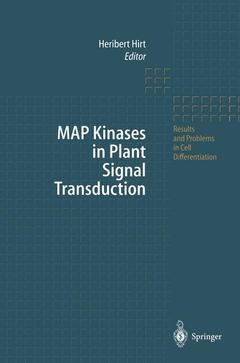Description
MAP Kinases in Plant Signal Transduction, Softcover reprint of the original 1st ed. 2000
Results and Problems in Cell Differentiation Series, Vol. 27
Coordinator: Hirt Heribert
Language: English
Subjects for MAP Kinases in Plant Signal Transduction:
Publication date: 07-2012
168 p. · 15.5x23.5 cm · Paperback
168 p. · 15.5x23.5 cm · Paperback
Description
/li>Contents
/li>Comment
/li>
This book deals with Mitogen Activated Protein Kinase (MAPK) pathways : modules involved in the transduction of extracellular signals to intracellular targets in all eukaryotes. In plants, MAPKs are playing a role in the signaling of abiotic stresses, pathogens, plant hormones and cell cycle cues.
MAP Kinases in Plant Signal Transduction.- 1 MAPK Modules Form Basic Units of Eukaryotic Signal Transduction.- 2 Different MAPK Pathways Exist for Different Signals.- 3 What Are So Many Plant MAPK Genes For?.- 4 Arabidopsis: Emerging MAPK Modules.- 5 MAPKs and Stress Signaling.- 6 Cell Cycle.- 7 Auxin.- 8 Abscisic Acid and Giberellins.- 9 Ethylene.- 10 Concluding Remarks.- MAP Kinases in Plant Signal Transduction: How Many, and What For?.- 1 Introduction.- 2 The Structure of MAPKs.- 3 MAPKs in Yeast and Animals.- 4 Plant MAPK.- 5 Plant MAPKs Can Be Classified into Five Groups.- 6 PERK Groups: Towards a Functional Classification System of Plant MAPKs.- 7 How Many Are Out There? Plant ESTs with Similarities to MAPKs.- Reference.- MAP Kinase Cascades in Arabidopsis: Their Roles in Stress and Hormone Responses.- 1 Introduction.- 2 MAPK Cascades Involved in Stress Responses in Animals and Budding Yeast.- 3 Arabidopsis Homologs of Protein Kinases in MAPK Cascades.- 4 Transcriptional Control of the Putative Components of Arabidopsis MAPK Cascades in Response to Environmental Stresses.- 5 Activation of MAPK-Like Activity by Environmental Stresses in Arabidopsis thaliana.- 6 Analysis of Functional Interactions of the Components of MAPK Cascades in Arabidopsis Using the Yeast System.- 7 Putative Upstream Factors of MAPK Cascades in Arabidopsis.- Reference.- MAP Kinases in Pollen.- 1 Pollen Development and Germination.- 2 Signal Transduction in Pollen.- 3 Changes in Pollen Grains After Hydration.- 4 MAP Kinases in Pollen.- 5 The Response of MAP Kinase Signaling Pathways to Osmotic Stress.- 6 Specificity of the MAP Kinase Response.- Reference.- Mitogen-Activated Protein Kinases and Wound Stress.- 1 Introduction.- 2 Evidence for Activation of MAPK-Like Protein Kinases by Wounding.-3 Evidence for Activation of MAPKs by Wounding.- 4 Transcriptional Activation of MAPKs by Wounding.- 5 Systemic Activation of MAPKs by Wounding.- 6 What Is the Initial Wound Signal for Activation of MAPKs?.- 7 Studies of Function of MAPKs Using Transgenic Plants.- 8 Concluding Remarks.- Reference.- Pathogen-Induced MAP Kinases in Tobacco.- 1 Introduction.- 2 Salicylic Acid-Induced Protein Kinase (SIPK).- 3 MAP Kinases Activated by a Cell Wall-Derived Carbohydrate Elicitor and Purified Proteinaceous Elicitins from Phytophthora spp.- 4 Activation of SIPK by Bacterial Harpin.- 5 Activation of SIPK and WIPK by TMV.- 6 Activation of SIPK and WIPK by Avr9 from Cladosporium fulvum.- 7 Wounding and MAP Kinase Activation.- 8 General Discussion.- Reference.- Receptor-Mediated MAP Kinase Activation in Plant Defense.- 1 Introduction.- 2 Phytophthora sojae Elicitor-Induced Responses of Parsley Cells: A Model System for Plant-Pathogen Interaction.- 3 Pep-13 Elicitor Binds to a 100 kDa Plasma Membrane Receptor.- 4 Signal Transduction Events of Pep-13 Elicitor-Induced Defense Responses.- 5 Pep-13 Elicitor Induces Activation of a MAP Kinase.- 6 MAP Kinase Activation Occurs Through the Pea-13 Recentor.- 7 MAP Kinase Activation Is Dependent on Ion Fluxes.- 8 MAP Kinase Activation Is Independent of Oxidative Burst.- 9 Activation of MAP Kinase Is Correlated with Its Nuclear Translocation.- Reference.- Regulation of Cell Division and the Cytoskeleton by Mitogen-Activated Protein Kinases in Higher Plants.- 1 Regulation of the G1/S Transition: The Animal Paradigm.- 2 The Plant Players of G1 Control.- 3 Regulation of G2/M Transition: The Animal Paradigm.- 4 Plant Mitosis; Mechanically Different but the Regulation Might be the Same.- 5 Spatial Regulation of Cell Division and Growth are Dictatedby Plant Specific Cytoskeletal Structures.- Reference.- The MAP Kinase Cascade That Includes MAPKKK-Related Protein Kinase NPK1 Controls a Mitotic Process in Plant Cells.- 1 Isolation of the NPK1 cDNA.- 2 Identification of NPK1 as a MAPKKK.- 3 Structural Features of NPK1 and Its Arabidopsis Homologs, ANP1/2/3.- 4 Activity of ANP1 May be Regulated by Differential Splicing.- 5 Expression Pattern of the NPK1 Gene.- 6 Upstream and Downstream Factors of NPK1.- 7 Possible Function of NPK1.- Reference.- Mitogen-Activated Protein Kinase and Abscisic Acid Signal Transduction.- 1 Introduction: Facts and Speculation.- 2 Physiology of ABA.- 3 Signal Transduction Cascades of ABA.- 4 MAP Kinase Activation by ABA.- 5 The Importance of Protein Phosphatases for ABA Signalling.- 6 Conclusions.- References.- Signal Transduction of Ethylene Perception.- 1 Introduction.- 2 Detection of Phosphorylation Events in Ethylene Signal Transduction.- 3 A Survey of Putative Genetic and Molecular Components of the Ethylene Signal Pathway.- 4 Dynamics of Ethylene Perception and Signal Transduction.- Reference.
This book summarizes the latest results in the field of MAP Kinases in plant signal transduction Includes supplementary material: sn.pub/extras
© 2024 LAVOISIER S.A.S.




